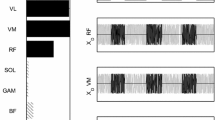Abstract
Ten subjects made rapid, simultaneous movements of jaw (elevation or lowering) and right foot (ankle flexion or extension) in two experimental situations: (1) in response to an external signal (reaction-time situation), and (2) in a self-paced situation. We calculated the mean time intervals between the onsets of electromyographic (EMG) activity of agonist muscles (tibialis anterior or gastrocnemius lateralis compared with masseter or digastricus pars anterior) and those between the onsets of movement acceleration at each joint. Despite the fact that subjects reported simultaneous jaw-foot movements, there was always a short time interval between the two movements as between the agonist EMG activities. When the subjects were asked to perform a jaw elevation movement simultaneously with an ankle movement (flexion or extension), the sign of the time interval was dependent on the situation of movement initiation. In the reaction-time situation, the jaw motor activity preceded that of the ankle, whereas the reverse temporal order was observed in the self-paced situation. This is consistent with a previous hypothesis suggesting that the simultaneity of two motor actions is centrally established through two separate central processes: reactive or predictive. When subjects tried to perform simultaneous jaw lowering and foot flexion or extension movements, the strict temporal order observed when considering jaw elevation and ankle movements disappeared. The jaw motor activity generally preceded that of ankle in the reactive situation, but, depending on the subjects, it preceded or followed the ankle motor activity during self-paced movements. It is likely that the specific spindle supply of jaw muscles accounts for these results. Indeed, the jaw depressor muscles, in contrast to the elevators, lack muscle spindles. Our results suggest that the kinesthetic inputs used by the upper central nervous system to synchronize two rapid voluntary movements are mainly those from spindles located in the muscles that accelerate the movement, suggesting a strong α-γ linkage.
Similar content being viewed by others
Author information
Authors and Affiliations
Additional information
Received: 31 October 1996 / Accepted: 1 September 1997
Rights and permissions
About this article
Cite this article
Devanne, H., Maton, B. Role of proprioceptive information in the temporal coordination between joints. Exp Brain Res 119, 58–64 (1998). https://doi.org/10.1007/s002210050319
Issue Date:
DOI: https://doi.org/10.1007/s002210050319



